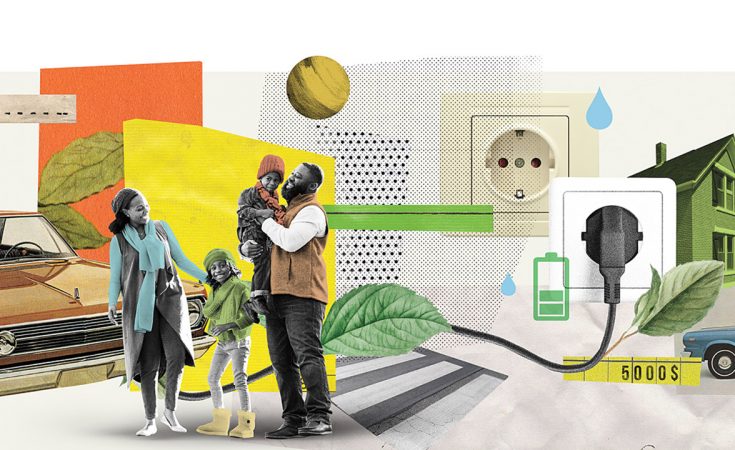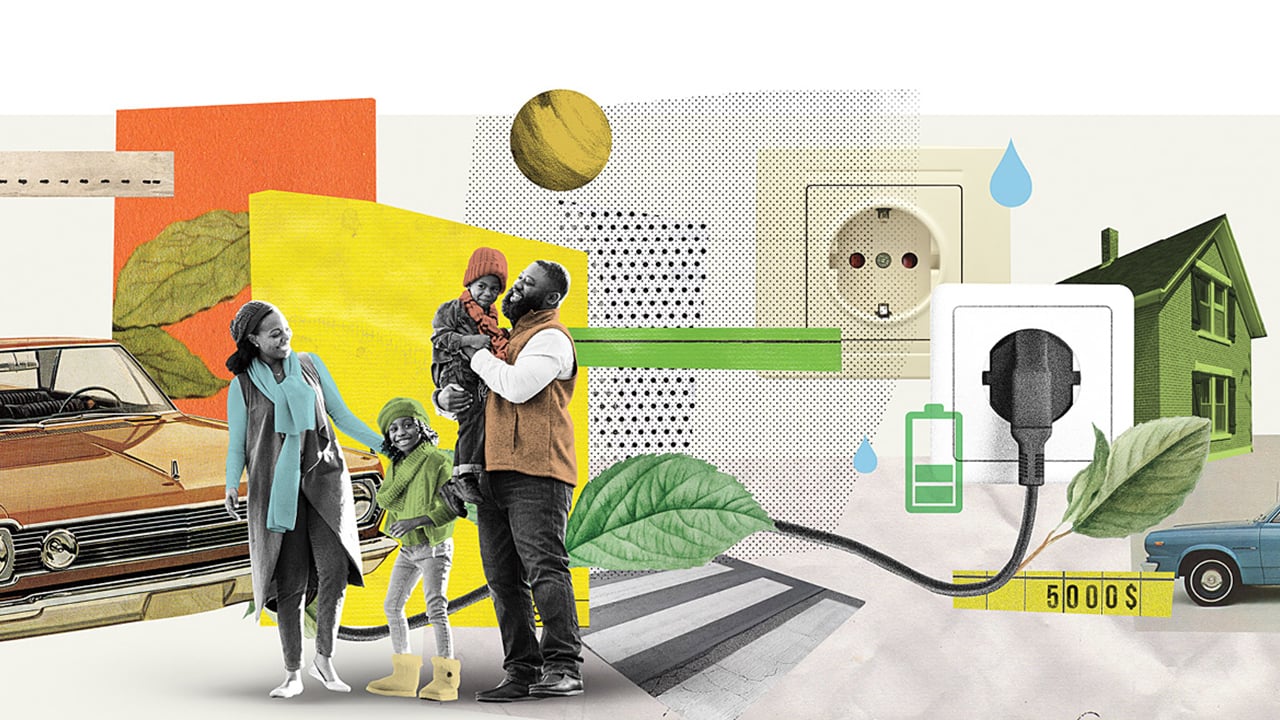When I went electric car shopping four years ago, I couldn’t find anything that matched the convenience, price and size of my Honda SUV. I guiltily ended up with a lease on another CR-V, betting that the technology would catch up to the needs of my family (wife, two boys, best friends, goalie equipment, Costco hauls and, now, a dog). Spoiler alert: It has. The new 2022 and 2023 electric SUVs hitting the market have erased most of the fears about going electric and, as they say in car speak, come loaded with some surprising extra features, too.
No more arguments about who forgot to gas up
“If I’m riding in somebody else’s vehicle, I’m like, ‘We have to go to the gas station?’ How annoying is that?” says Lisa Deacon, who has a six-year-old and a toddler and has been driving a zero-emissions car since 2019. For electric vehicle (EV) owners, “filling up” is just like charging a phone: You simply plug in your car overnight when electricity is cheap and you’re fully charged and ready for daycare drop-off in the morning. The stress of gas price hikes? Gone. “The cost of refuelling my car is $8 for 350 km of range,” says Nino Di Cara, a Toronto dad and founder of Electric Autonomy, a news outlet that reports on the low-carbon vehicle transition. Since about 80 percent of EV charging happens at home, you’ll benefit most from the convenience if you can power up at your house. “And you don’t freeze your butt off in the middle of January at a gas pump,” adds Deacon, who lives 50 km outside of Ottawa and used to regularly commute into the capital.
You don’t have to downsize with an electric SUV
While sedans and hatchbacks dominated the affordable EV market in the past, Volkswagen, Nissan and Hyundai have all introduced new electric SUVs with generous interior space, decent cargo room and optional AWD. (Toyota promises the bZ4X, similar to the RAV4, later this year.) Keep in mind that EVs are built differently than their gas predecessors, which usually means more room for passengers (and their stuff) in a smaller footprint. Some also have a “frunk”—a trunk in the front where you would normally have an engine.
Yes, you can still take road trips in electric vehicles
Thanks to a leap in battery technology, the driving range on the long-range models of the Hyundai IONIQ 5 and Nissan Ariya crossover is about 480 km, and the entry-level Volkswagen ID.4 clocks in at about 400 km, which will easily zip you up to cottage country—or from Calgary to Canmore and back. Even if you do need to make a pit stop, one of the step-up improvements coming with the 2022 and 2023 introductions is faster charging speeds. That Hyundai, for instance, can go from 10 percent to 80 percent capacity in about 20 minutes at an ultra-fast charger, versus hanging around for an hour.
Longer road trips, like that ride down to Florida, are without a doubt still going to require more planning while roadside charging networks become more reliable over the coming years. Still, this shouldn’t necessarily be a deal breaker. “We’re beyond the point now of feeling that it’s inconvenient,” says Di Cara. “It’s nice to plan and know where we’re going to go and visit the washroom, grab a coffee, take a break. And by the time we’ve sorted ourselves out, the charge is practically done and we’re back on our way.” Deacon, who is planning a road trip to Sydney, NS, this year, doesn’t stress about it either. “Like any family, you need to make a couple of stops anyhow, to keep the kids active.”
Going electric is the right thing to do
When you lease or buy another conventional vehicle, you’re locking yourself in to years of burning fossil fuels. The tipping point for Di Cara was dropping off his son, Dane, at school and seeing lines of cars parked and idling. “We’ve banned smoking near schools but we’re still letting toxic fumes from tailpipes loiter around our kids,” he says. According to Public Health Ontario, more than a quarter of elementary schools in the province are in the TRAP (traffic-related air pollution) zone for high vehicle emission exposure. “Because of the pandemic, there are a lot of people who are moving out of the city looking for more space in the countryside,” adds Deacon, who lives rurally. “We knew there would be fewer public transit options. That was a big impetus for us to buy an electric vehicle so that, yes, our commute was farther, but it would also have a lower carbon footprint. It’s all about doing what you can and teaching our kids that we can try new things.”
It’s really fun to drive EVs
An EV is to the combustion car as the iPhone is to an old flip phone. It just feels like the future, gliding off silently when you turn it on (remember—there’s no actual “ignition” of flammable fuels). “It’s a very calm, smooth experience because there are no cylinders firing and pistons vibrating in front of you,” explains Di Cara. “When you put your foot on the accelerator, the car just rolls forward in silence. It never gets old.” In the new models, the batteries span the centre of the car, rather than a heavy engine up top, which translates into a lower centre of gravity and better handling. EVs are also far more responsive, accelerating and decelerating immediately—what owners have dubbed one-pedal driving. This is thanks to a magical thing called regenerative braking, which uses the vehicle’s motor to slow itself down, recharging the battery in the process. This means that when you’re stuck in stop-and-go traffic, unlike a gas vehicle, which will burn more fuel, you actually lose less charge. (Not that it makes it any more fun with a hangry toddler in the back.)
Your new car would double as a backup generator
Your electric car is a car, but it’s also a giant battery. Some of the newer models, like the Hyundai IONIQ 5, feature a capability called vehicle-to-load (V2L)—really just a fancy way of saying that you can plug things into it. (There’s an outlet outside the car, plus another one inside the cabin on certain trims.) That means you can sneak off to run a breast pump in the back seat at your friend’s vineyard wedding, or keep that freezer in your garage from thawing during a blackout. Automakers and charging-station manufacturers are also working on something called bidirectional charging, which could power your whole house during an outage, but only a few EVs, like the new Ford F-150 Lightning trucks and Nissan Leaf, are ready out of the box. As climate change makes weather more unpredictable, this kind of resiliency won’t just be a party trick but the killer app that makes EVs essential.
The government will pay you to buy an electric vehicle
If you purchase or sign up for a 48-month lease on an eligible electric vehicle (base MSRP of $45,000 or less), the federal government will contribute up to $5,000. Crossover manufacturers have responded with sticker prices in the $40,000s to qualify. The result is a win-win for value-seeking families. Most provinces and territories (sorry, Ontario) offer additional incentives, meaning you can easily end up with $10,000 in combined incentives for a new vehicle purchase in some parts of the country, bringing the cost more in line with a comparable combustion vehicle. For a Quebec family looking to purchase a $44,995 Volkswagen ID.4, for instance, the real cost would be only $31,995 after both incentives—just a bit more than its Tiguan cousin, but with far lower ongoing maintenance costs. Plus, your local dealership is responsible for processing the paperwork and ensuring you receive the rebate.
Deacon would love for more people to experience an EV to get over the mental hurdle. “You’re not giving anything up—you’re only adding to the convenience and the comfort,” she says. She’s even convinced her most skeptical relatives. “My dad’s a mechanic, and my uncle is a geologist in Alberta. They’ve both made their livelihoods off of oil and gas. But on their first drive with us, they were shocked at the power that an electric vehicle has. They were like, ‘Gosh, our nicest gas vehicles could never do what this vehicle does.’” Di Cara’s son, who’s eight and something of a racing car enthusiast, does have one regret about the switch to electric: “I wish it growled more. That sounds way cooler.”
Charging 101
Electric vehicles plug in to charge. How does that work, exactly?
Level 1: Standard wall outlet
Your car will come with a power cord that you simply plug into the car (you’ll find the charge port where you’d usually find the gas tank) and then into any normal wall outlet. The only drawback is speed: three to four nights to get back up to full charge. (Overnight charging lets you take advantage of time-of-use savings, since many utilities charge higher peak daytime rates.)
Level 2: Home charging station
If you have a long commute, you’ll likely want to upgrade to a charger that will let you power up a next-gen SUV in about five hours. It’s a small box that can be mounted in your garage or outdoors and, like an electric dryer, draws more voltage (240 V). A licensed electrician will need to handle the installation, and costs start at around $1,250 and up, including the dock.
Level 3: Fast charger
Also called DC charging, this is lightning fast and will charge your car in 20 to 40 minutes while you take a break on the highway. Chargers are a bit like Android and Apple: Note that Tesla superchargers aren’t compatible with other vehicles. (And sorry, you can’t install one of these in your garage because it would cost more than your car.)
If you can’t plug your car in at home–for instance, if you live in a condo and your board won’t budge on installing chargers, or you park your car on the street outside your home—you’ll lose most of the convenience of an EV until public chargers become more widespread.



































